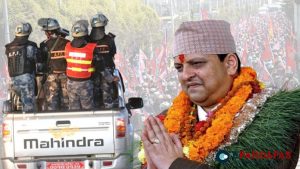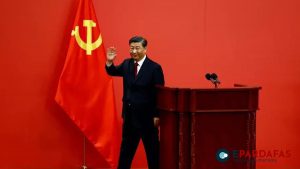
Construction of Nepal-China Friendly Industrial Park in Limbo Amid Protests and Land Disputes
The construction of the Damak Clean Industrial Park, also known as the Nepal-China Friendly Industrial Park, has plunged into uncertainty, marked by continuous protests and disputes over potential displacement of local residents.
Originally intended to span across 2200 bighas of land, only 1200 bighas have been confirmed for the park, triggering vocal opposition following the announcement of compensation at the rate of NPR 5 lakh per bigha.
The fate of this ambitious project, aimed at solidifying Chinese investment and action plans, hinges on the completion of the detailed study report (DPR) for the park.
Initiated by the then KP Oli government over seven years ago and having its foundation stone laid by Oli himself three years ago, the construction is estimated to cost NPR 65 billion. Although the Investment Board granted approval for the project, the investment details remain unsettled.
Initially, the park was intended to encompass areas under Damak and Gauradah Municipalities and Kamal Rural Municipality in Jhapa, but the designated area has now been reduced to 1200 bighas. It was suggested that Chinese government-backed investments would support this project under the Belt and Road Initiative (BRI), involving the Lhasa Economic and Technological Development Zone in Tibet and the Jingping Joint Creation Construction Project Development.
However, disputes over land ownership, compensation, and local residents’ opposition have led to a standstill despite initial reports of Chinese investments. Amrit Lamsal, Joint Secretary and spokesperson for the Board of Investment, mentioned that although it was agreed that a company based in Lhasa, China, would seek investment, it cannot always be attributed to the Belt and Road Initiative (BRI).
“Amidst multilateral discussions surrounding the PDA agreement, the foundation of the agreement remains uncertain,” said Joint Secretary Amrit Lamsal, spokesperson for the Board of Investment, in a statement. Lamsal also pointed out that although it was previously agreed that a company based in Lhasa, China, would seek investment, not all support and investment from this source can be categorically attributed to the Belt and Road Initiative (BRI).
On July 7, an official from the Tibet Department of Commerce, Zhao, had already sent a ‘precautionary letter’ to the Nepali Consulate General in Lhasa regarding the investment in this park and the confusion surrounding land ownership. Subsequently, the letter from the Tibet Department of Commerce, transmitted by the embassy, was registered with the Ministry of Foreign Affairs on July 9 and with the Industrial Zone Management Limited on July 13. Bhushan Kumar Upadhyay, Company Secretary of Industrial Area Management Limited, clarified, “However, relevant authorities have yet to make decisions regarding the planning, ownership, and compensation for the construction of this park.”
While the establishment of such industrial zones typically involves a limited company selecting a location and conducting an industry justification study, the case of Damak’s industrial park appears to have been influenced by political pressure and lobbying during the time of the former UML government.
Tibet’s Department of Commerce official Zhao raised concerns about the park’s construction, triggering confusion regarding land ownership and investments. The concerns have yet to be addressed by the relevant authorities.
Political pressure and lobbying seemingly played a role in advancing this project, circumventing the standard process of location selection and industry justification studies. While the project’s multilateral discussions continue, foundational agreements remain elusive.
The industrial park’s developments stand in stark contrast to its grand inauguration by former Prime Minister Oli in February 2021. Nearby, a ‘First Citizen Dhimal Statue’ unveiled by Oli in 2018 has been placed with honor, yet the industrial park’s proximity to this statue is marked by grazing cows and goats.
According to News by Devendra Bhattarai, a senior journalist in Kantipur Daily, Local residents, such as Gajendra Dhimal, who was compelled to accept compensation for his land, now seek livelihoods in alternative professions. Similar circumstances are faced by other locals, including Kamala Basnet, Indra Bahadur Basnet, and Bishnu Bahadur Dhimal, who chose to form protest committees due to dissatisfaction with their compensation amounts.
The controversy extends to compensation rates that vary significantly between neighboring municipalities and disputes over land categorized by factors like its proximity to the river or road. Additionally, disputes affect unmeasured land in the Sarpat area within Damak Municipality.
According to Ramesh Raj Nepal, an official involved in compensation arrangements, 238 bighas of landowners are yet to claim their compensation. Double taxation cases, outdated property valuations, and appeals against compensation amounts add complexity to resolving these disputes.
The park’s development has also impacted long-term residents, including 10 families of Rai Khalak, who relocated from Sankhuwasabha to Damak in 1966. Sita Rai, a 60-year-old resident, lamented the loss of her family’s land and the challenges faced in securing compensation, causing financial hardships.
Devi Dahal, another local resident, criticized the government for not blocking the zone before acquiring land, leading to a situation where some who profit from land transactions and compensation claims are reaping the rewards while others are being wronged.
An estimated 400 bighas of government-owned land exist within the park’s boundaries, alongside 57 individuals who possess 25 bighas of land with no documented land survey records, adding further complexity to the issue.













Comments